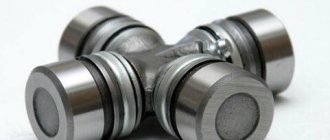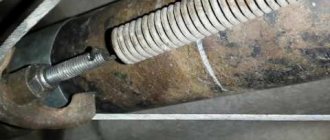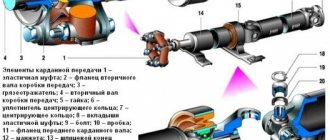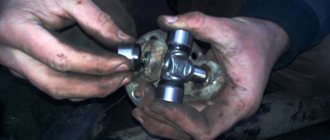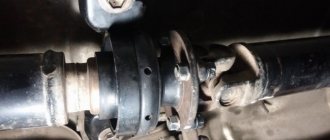There are several possible reasons for the negative change. First of all, this may be due to the initial incorrect adherence to the exact dimensions of individual parts
The entire design of the driveshaft consists of several elements located on the same axis. In this regard, it is very important that this part is always in a state of balance. If this condition is violated, the remaining components of the automobile transmission will experience serious load. In the future, the imbalance can lead to failure of not only the cardan transmission, but also other components of the machine.
Video of cardan balancing in the garage
The higher the angular velocity of the part, the greater the likelihood of its imbalance, and vibration can be eliminated only and exclusively on complex balancing machines. Moreover, the larger the part, the more complex the equipment should be. Balancing the driveshaft with your own hands, video attempts of which we presented below, as a rule, gives only psychological results, but by no means real ones.
The fact is that it is possible to eliminate the balance of the cardan transmission only if the location and weight of the imbalance are accurately verified, and the cardan must be balanced exclusively in the assembly with the crosspieces. In a garage and without balancing equipment, this is only possible with a cardan installed on the car. Technologically this is impossible to accomplish. Eliminating the imbalance itself is a matter of five minutes, but the main thing is to calculate the exact location, cause and eliminate it.
Causes of imbalance
The following can contribute to shaft malfunction:
- natural wear of the part during long-term continuous use;
- failure to comply with technical regulations for the use and maintenance of the machine;
- manufacturing defects;
- mechanical damage that occurs when interacting with a solid object, etc.
A sign that an unbalanced condition of the shaft has arisen is an increase in the level of vibration of the cardan when driving to the point of discomfort for the driver and passenger in the car.
What is an imbalance and how to eliminate it
The main sources of vibration in a car are large parts with high angular velocity, namely: the driveshaft, automatic transmission torque converter, wheel, crankshaft and flywheel with clutch assembly. If the center of mass of a part does not coincide with the longitudinal axis along which the part rotates, an imbalance will inevitably occur. From a physics point of view, imbalance is the product of the weight of the part and the mass of the eccentricity.
Balancing the driveshaft is the only effective method for removing imbalance. To eliminate it, it is necessary to attach a load to the cardan that is equal in weight, but opposite in sign to the eccentricity. In this case, it is very important to maintain the coincidence of the axes and the location of the suspensions when balancing with the axes and suspension points in real working conditions. In cases with those parts whose length is significantly less than the axis of rotation (wheel, flywheel), it is enough to hang the part by only one point, which greatly simplifies the balancing work. It is also necessary to take into account that the rolling resistance at the suspension point should be minimal and the accuracy of determining the location and module of the imbalance often depends on this. The part simply rotates and stops at the place where the unbalance point is at the bottom. All that remains is to simply mark this point and install a correction weight, and then repeat the operation.
Car operating rules
In order for the driveshaft to last longer, you must follow some rules that will help the part be subjected to less stress during operation:
- Try to limit driving on uneven roads, as constant shaking will negatively affect the geometry of the driveshaft.
- Drive away smoothly, avoiding unnecessary slipping and sudden starts, which significantly increase the load on the vehicle's chassis.
- Once you get into a hole, try to get out of it smoothly, without rocking the car. Carry special mats with you to place under the wheels to minimize the risk of breaking the chassis or driveshaft.
- Do not shift gears abruptly to reduce the load on the special elastic coupling.
- Contact a car service in a timely manner for a complete diagnosis of the vehicle, as well as for advice on car repair and maintenance.
- Do not wash driveline components with high pressure, as water may enter the system;
- Do not heat the shaft when trying to remove old paint - this will disrupt the uniformity of the metal;
- Periodically check the tightness of the fasteners to prevent them from loosening and increasing the load on the moving parts.
- Use lubricants recommended by the manufacturer to protect connections from wear due to sliding.
- Avoid excessive loads on the transmission and driving at high speeds.
Features of balancing the cardan drive
In the case of a cardan shaft, we are dealing with a part whose length significantly exceeds its diameter, and the imbalance may have the same module, but a different direction vector. This is called moment imbalance and can only be calculated using driveshaft balancing equipment. Such vibrations can only be treated with dynamic balancing, which requires calculating and eliminating several imbalances at once.
An imbalance of the cardan can occur not only due to its damage, but also in some other cases:
- factory defects (different cardan pipe wall thicknesses, poor-quality and incorrect fixation of the lugs);
- the occurrence of gaps in the cardan transmission elements;
- curvature of the shaft itself;
- spline wear.
In addition, in most cases, dynamic balancing of the new cardan is necessary, and after each repair, the cardan shaft must be balanced. The price of this operation in special centers depends on the car model, and the approximate cost of the work is given in the table.
Signs and causes of imbalance
The main sign of an unbalanced driveshaft of a car is the appearance of vibration in the entire body of the car. Moreover, it increases as the speed increases, and depending on the degree of imbalance, it can appear both at a speed of 60-70 km/h and at more than 100 kilometers per hour. This is a consequence of the fact that when the shaft rotates, its center of gravity shifts, and the resulting centrifugal force “throws” the car on the road. An additional sign, in addition to vibration, is the appearance of a characteristic hum emanating from under the bottom of the car.
Imbalance is very harmful to the transmission and chassis of the car. Therefore, when the slightest signs of it appear, it is necessary to balance the “universal shaft” on the machine.
Neglecting a breakdown can lead to such consequences
There are several reasons for this breakdown. Among them:
- natural wear of the part during long-term use;
- mechanical deformations caused by impacts or excessive loads;
- manufacturing defects;
- large gaps between the individual elements of the shaft (if it is not solid).
The vibration felt in the cabin may not come from the driveshaft, but from unbalanced wheels.
Regardless of the reasons, if the symptoms described above appear, it is necessary to check for imbalance. Repair work can also be done in your own garage.
How to balance a driveshaft yourself
Based on the information received, it is clear that without special equipment there can be no talk of any precise balancing. However, if a situation arises where it is necessary to carry out balancing, but there is no such workshop nearby, as a temporary measure you can do the following:
- the cardan is conventionally divided in the longitudinal plane into 6-8 parts;
- a weight (15-30 g) is attached to each of the sectors in turn; this can be a weight for balancing wheels;
- the car is taken out onto a flat road and a check is carried out to determine whether the vibration has been eliminated or has become even greater;
- After this, the cargo is moved to another sector.
It is clear that this method will only remove the main imbalance and in no way claims to be accurate, but it will allow you to get rid of vibrations for a while and get to the service station. Make sure the rotating parts are balanced and enjoy your travels!
Second level heading
But the most common cause of failure is deformation of all shafts due to damage during operation, as well as mechanical or thermal treatment. Shaft balancing is a necessary thing.
Third level heading
There are several possible reasons for the negative change. First of all, this may be due to the initial incorrect adherence to the exact dimensions of individual parts of the cardan transmission during their production.
Heterogeneity or uneven density of the material from which the parts were made can also ultimately cause the cardan to quickly become unbalanced.
The reasons also include insufficient accuracy of the overall centering of the joints of the parts, the presence of air gaps in the nodal and detailed joints and the mismatch of their axes when installing the cardan. It is necessary to balance the shafts.
What not to do
If the splines have come apart, you should not listen to advice like “You can simply move around the spline and when the imbalance goes away, this is the correct position.” Firstly, it’s wrong, and secondly, it takes a very long time.
By changing the position of the splines, you will achieve a reduction in vibration, but with a high probability you will not find the correct position of the cardan. The imbalance will decrease, the feeling of vibration in the body will disappear, but a small, imperceptible vibration on the cardan will remain.
Minor vibration can quickly destroy the outboard bearing and crosspiece. It is also likely that the gearbox, axle or transfer case will suffer - usually the first signs are leaking seals.
Ventilation balancing
Replacing the driveshaft crosspiece of a VAZ 2107
Industrial fans operate under enormous loads. The parts gradually become covered with dirt and wear out. This leads to increased vibrations, which causes damage to the unit. To avoid this, regular maintenance and repair of the fan is required. An obligatory part of the repair work is balancing the ventilation.
Vibration appears when unbalanced:
• impellers;
• blades;
• impellers;
• rotor.
The procedure is carried out on balancing machines. The employees performing it need knowledge of different types of fans and many years of experience, which will allow them to accurately determine the cause of the imbalance and develop the correct way to eliminate it.
Before balancing the fan, special sensors are attached to it. They determine the level of vibration. The data is processed by computer. The result of the imbalance is displayed on the display - information is displayed where you need to add or remove weight.
After installation of the correction mass, a repeat test is carried out to find out whether the imbalance has reached the acceptable level of the norm.
Balancing the fan parts guarantees the safety of its operation and the normal functioning of the ventilation system.
What is a flywheel?
A flywheel is a disc-shaped component of a car that connects to the crankshaft. Although it has virtually no moving parts, it is essential to the proper functioning of the crankshaft. Its main task is to create inertia for some car parts. In addition, it connects the starter and the shaft, which ensures that the engine starts working.
This is a rather massive element of the car that prevents the pistons from remaining motionless. Thanks to its large mass, it allows you to easily start the movement of other mechanisms.
However, the high mass does create one problem: balancing. If this element has a displaced center of gravity, then rotation leads to additional forces. Displacement occurs for various reasons, be it defective, wear of a part or incorrect installation
However, it is important that these forces lead to vibration, which is extremely dangerous for car parts
In this part of the car, even slight vibration can lead to significant damage to parts. Destruction of the starter, crankshaft and other components is not the limit if this factor is neglected
Therefore, it is important to monitor the center of gravity of the flywheel and, if necessary, balance
Purpose of intake flaps
At idle and at low engine speeds, the intake flaps are closed. As a result, intense vortex motion occurs, ensuring good mixture formation.
During engine operation, the position of the intake flaps is smoothly adjusted depending on the engine load and speed. Thanks to this, in each engine operating mode, optimal vortex air movement is formed in the combustion chamber.
At speeds above 3000 rpm, the intake flaps are fully open. By increasing the throughput of the dampers, good filling of the combustion chambers is ensured.
When starting the engine, in emergency mode and at full load, the intake flaps are fully open.
Terminology
- Imbalance is a mismatch between the axis of rotation of a body and its main axis of inertia. This imbalance of the rotating elements of propeller shafts or other rotors causes vibration. The latter will cause fatigue cracks in the cardan support, which will quickly develop into breakdowns. Threaded connections subject to vibration gradually become loose and untwisted. This can lead to an emergency situation due to the gimbal falling while the vehicle is moving. In addition, vibrations have a negative impact on the driver: they contribute to rapid fatigue and distract him from assessing the road situation, and also increase the risk of an accident.
- The main axis of inertia of a tree is the axis of symmetry passing through its center of mass.
- Balancing transmission shafts is the process of eliminating their imbalance, which consists of moving the main axis of inertia until it is aligned with the axis of rotation.
The first symptoms of wheel imbalance
Before wondering where to balance the driveshaft, you need to learn about the most common symptoms of a problem in order to determine in time when you need to take your car to a service center:
- When accelerating to certain speeds, a strong vibration is felt in the car. Moreover, the stronger it becomes, the more the wheels become imbalanced. Strong shaking is dangerous because the car can skid (especially in the winter season).
- Extraneous noises during a trip are also a kind of symbol of the fact that the car is gradually beginning to break down in the area of the cardan and other parts related directly to the vehicle’s chassis system.
Note! Since the driveshaft includes many small parts, they often fail before others. Therefore, it is often necessary to resort to complete replacement of components that are relatively inexpensive. There is no need to skimp on this by trying to manually restore the part, since any intervention can lead to complete failure of the unit.
Main types
There are several ways to classify such products. Among all types they can be divided:
- According to their purpose, cardan shafts are of main and auxiliary types. The first type of product is also used as a basis for all types of drive wheel drive mechanisms. The second type of device plays an auxiliary role and can be used to organize the operation of winches, pumps and other similar mechanisms.
- Based on their structure and location, cardans can be divided into closed and open type transmissions.
- There are also mechanisms with compensation for axial displacement. These devices are universal. When this is not provided for by the design, they are called simple.
The driveshaft is a very important component of the car, on which its performance depends. Correctly setting up the mechanism will allow you to ensure efficient operation of the entire system.
Why is crankshaft balancing necessary?
When the crankshaft is unbalanced, the mass is distributed unevenly along and across the axis, that is, the balance is upset: one edge is lighter than the other. The main cause of lateral imbalance is wear of shaft parts during prolonged use.
Crankshaft balancing is carried out to reduce the load and vibration on the components of the power unit. This operation makes it possible to increase engine performance and extend service life. Basically, balancing is necessary for worn-out engine elements, but there are cases when a new car needs balancing.
Balancing the crankshaft in the garage
You can determine whether the crankshaft needs balancing by the behavior of the gear shift knob: it begins to wobble when idling. The same goes for the engine: if at idle the engine runs jerkily.
The causes of problems may be different:
- poor quality manufacturing of associated parts;
- heterogeneity of the material used for the crankshaft;
- backlashes resulting from violation of the gaps between mating elements;
- poor quality assembly;
- inaccurate centering;
- natural wear and tear.
Balancing crushers
Replacing the outboard bearing of the driveshaft of a VAZ 2107
The appearance of vibration in an agricultural crusher indicates a problem with the rotating part. It occurs due to the accumulation of dirt, wear or improper assembly.
If you do not pay attention to this in time, the equipment will quickly fail.
The situation can be corrected by balancing. Specialists will determine the cause of the vibration and repair the necessary part.
Balancing happens:
• static;
• dynamic.
To remove imbalances in the rotor or accelerator of centrifugal impact crushers and flat-type mills, static balancing is sufficient. For non-flat crushers, dynamic testing is performed.
The main principle of the procedure is to find the point of imbalance and neutralize it. To do this, corrective masses are attached or holes are drilled in the part being balanced.
To carry out the operation, special balancing machines will be required. The computer accurately determines the location of the load and reports when the degree of imbalance reaches an acceptable level.
The procedure must be carried out by qualified employees who are well versed in the design features of crushers and mills of various types.
Timely balancing will increase the life of the crusher.
Replacement of VAZ 2107 cardan crosspieces
Faulty crosspieces cannot be repaired. Theoretically, the universal joint is considered a very reliable part with a service life of more than 500 thousand km. In reality, even the highest quality crosspiece requires replacement after 50–70 thousand km. The reason for this is bad roads, intensive use of the car, etc. To replace the VAZ 2107 CC you will need the following tools and materials.
- set of wrenches;
- hammer and spacer made of soft metal;
- the spacer is slightly smaller than the diameter of the crosspiece lugs;
- round nose pliers or pliers;
- bearing puller;
- sharp chisel;
- metal brush;
- solid oil
Dismantling the VAZ 2107 cardan
Before replacing the CC, it is necessary to dismantle the cardan drive. This is done as follows.
- If the car has been in use for quite a long time, the cardan mounting nuts are filled with WD-40 or kerosene. After that they can be easily unscrewed.
- Use a sharp chisel or other tool to place marks on the flanges of the cardan and axle. This is necessary to ensure mutual alignment during subsequent installation of the cardan.
- Using a 13-mm wrench or socket wrench (preferably curved so as not to damage the threads of the nuts), unscrew the cardan mounting nuts. If the bolts start to spin, you should fix them with a screwdriver.
- The suspension bearing mount is removed.
- The cardan is pulled out.
Removing the VAZ 2107 cardan cross
The cups and bearings can be removed from the driveshaft clamped in a vice using a special puller. However, this device is not very convenient and is used extremely rarely. Usually a standard set of tools is used. Dismantling the cross is carried out in the following order.
- Using round-nose pliers or pliers, remove the retaining rings from four sides of the cross.
- Cups with bearings are knocked out of the eyes. Usually one of the cups flies out on its own after removing the retaining rings. The remaining three cups are knocked out through the spacer.
Before installing new CCs, the lugs, fork and grooves for the retaining rings are cleaned of dirt and rust with a metal brush. The installation itself is carried out as follows.
- Any two cups facing each other are removed from the new crosses.
- The crosspiece is inserted into the eyes of the end of the cardan.
- Cups with bearings are generously lubricated with grease or G' Energy grease and installed in place.
- Using a hammer and a soft metal spacer, the cups are driven in until a groove appears for the retaining ring.
- The other two cups are removed, threaded into the eyes and reassembled.
- The bearings are driven in until the retaining rings are secured.
- The remaining retaining rings are driven in.
Installing the cardan
When installing a cardan with new crosspieces in place, you must:
- lubricate all connections with grease;
- make sure that the lubricant does not get sand or dirt;
- check the condition of the crosspiece seals and, if necessary, replace them;
- install parts in accordance with the marks made during dismantling;
- First insert the splined part into the flange, and then tighten the cardan bolts.
Video: replacing the VAZ 2107 universal joint
Thus, to replace the cardan cross, all you need is the car owner’s desire to do it himself and a standard set of mechanic’s tools. Carefully following the instructions of specialists will allow you to do the work efficiently and avoid possible mistakes.
